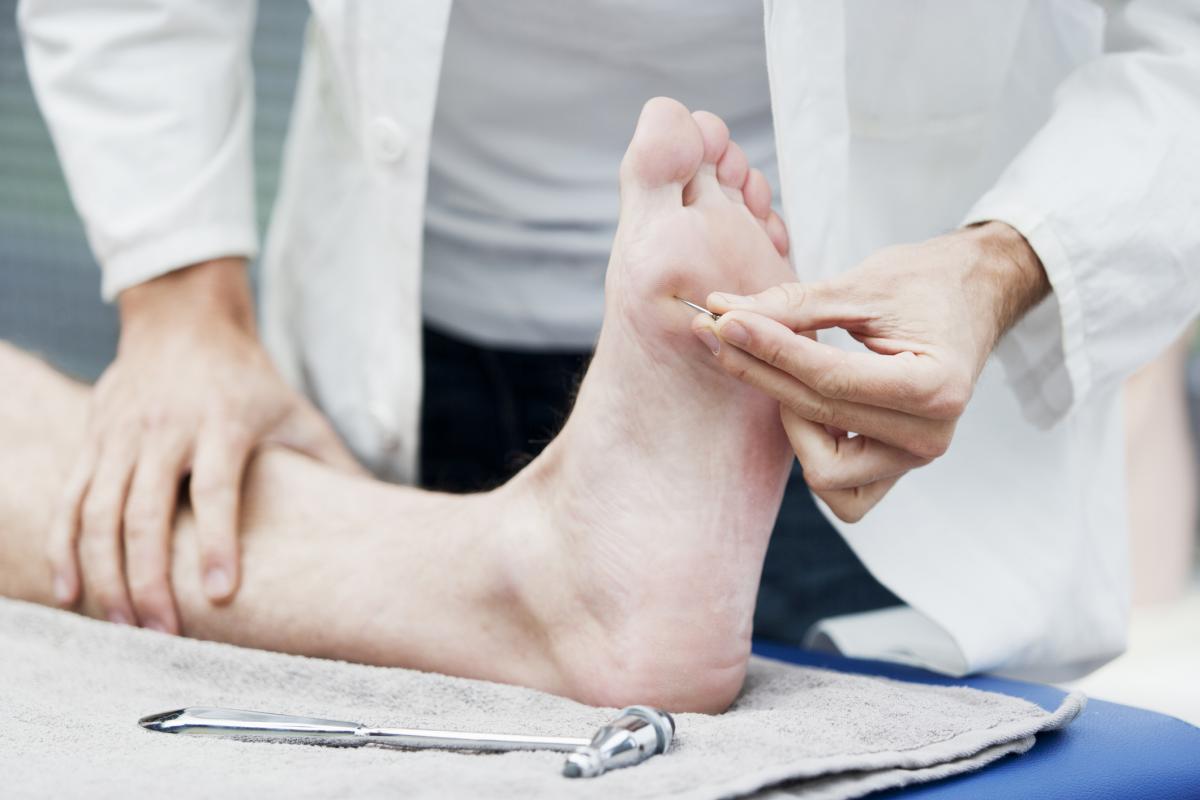Peripheral neuropathy

If you've noticed numbness or tingling in your feet and muscle weakness that's been going on for a while, it's possible you have a problem with your peripheral nervous system. It's the extensive, complex communications system that carries information between the brain and spinal cord and all other parts of the body, including skin, other major organs, muscles and extremities. Sometimes an injury, trauma or a specific disease or medical condition can damage this system.
What is peripheral neuropathy?
Peripheral nerves dispatch sensory signals from the head, face, eyes, nose, ears, muscles and the rest of the body to the brain and spinal cord. If you can sense a twitch in your eye or your hands feel cold, it's your peripheral nerves that are conveying that information through your brain. Peripheral nerves also carry instructions to muscles throughout the body from the brain and spinal cord to generate movement.
Damage to the peripheral nervous system is known as peripheral neuropathy. It disrupts the critical messages that travel between the brain or spinal cord and every other part of the body.
What are the classifications of peripheral neuropathy?
Peripheral neuropathy is classified into three areas:
- Mononeuropathy involves damage to only one nerve. Examples of mononeuropathy include carpel tunnel syndrome and sciatic nerve dysfunction.
- Multiple mononeuropathy occurs when at least two peripheral nerves in separate areas of the body are affected. It's considered a group of symptoms called a syndrome, not a disease.
- Polyneuropathy is more common than mononeuropathy. With this type, multiple nerves are affected. Polyneuropathy can be either acute or chronic. Acute polyneuropathy begins suddenly in both legs and progresses rapidly to the arms. In the most common form of chronic polyneuropathy, sensation is most affected. Abnormalities in sensation are often noticed first in the feet.
What are the types of peripheral neuropathy?
More than 100 types of peripheral neuropathy have been identified. Each can have its own symptoms and prognosis. These are common types of peripheral neuropathy:
- Small fiber peripheral neuropathy is a polyneuropathy that occurs from damage to small peripheral nerve fibers present in the skin. This type of neuropathy is usually characterized by a stabbing or burning sensation or itching or tingling.
- Large fiber axonal peripheral neuropathy affects the large fiber nerves responsible for motion control and the sense of where your body is in space. You may notice gait instability, numbness, weakness, wasting in small muscles and cramping pain at night.
- Chronic inflammatory demyelinating polyneuropathy (CIDP) is caused by an autoimmune reaction that damages the myelin sheath (an insulation around nerves). CIDP often causes limb weakness but may just cause problems with balance from numbness in the feet and legs. This is one of the few types of polyneuropathy where the underlying cause be treated.
- Charcot-Marie-Tooth disease involves a group of inherited nerve disorders. Symptoms usually start in childhood, but some people may not have problems until adulthood. Charcot-Marie-Tooth neuropathy often leads to significant weakness in the feet and hands.
What are the primary signs and symptoms of peripheral neuropathy?
You may experience:
- Numbness or tingling in the extremities
- Pricking sensations on the skin
- Muscle weakness
- Exaggerated or distorted sense of touch, called allodynia. It can include pain from typically painless experiences, such as a bedsheet brushing across the skin.
- Burning sensation on the skin
- Muscle cramping
- Muscle twitching
- Heat intolerance
- Loss of bladder control
- Drop in blood pressure when shifting from a seated to standing position, known as orthostatic hypotension
How is peripheral neuropathy diagnosed?
To diagnose your condition, your HonorHealth neurologist will use tests that include:
- Electromyography/nerve conduction studies, inserting a fine needle into a muscle to record electrical activity when muscles are at rest and when they contract
- Autonomic testing, which evaluates how your body reacts to specific stresses
- Skin biopsy to examine nerve fiber endings
- Nerve biopsy to examine larger nerve fibers
Causes and risk factors for peripheral neuropathy
These may include:
- Physical injury (trauma)
- Metabolic and endocrine disorders such as diabetes
- Small vessel disease that can decrease oxygen supply to the peripheral nerves
- Autoimmune diseases, such as lupus and rheumatoid arthritis
- Kidney disorders
- Cancers
- Infections
- Exposure to toxins
- Medication toxicity
- Heavy alcohol consumption
- Genetic mutations
Treatment options for peripheral neuropathy
Depending on the form of neuropathy you have, your HonorHealth neurologist will use one or more of these treatments:
- Medications that can diminish painful symptoms, such as duloexetine, gabapetin, and pregabalin
- Corticosteroids and other drugs that inhibit immune response
- Intravenous immunoglobulin, an infusion therapy administered to lessen the impact of specific inflammatory cells
- Plasmapheresis, a procedure in which the blood is removed, cleansed of immune system cells and antibodies and then returned to the body. This treatment is used for severe cases.
Your neurologist may also recommend that you adopt of a healthy lifestyle, which includes maintaining a body weight within the normal range of the body mass index, eating a balanced diet, exercising, addressing vitamin deficiencies and reducing alcohol consumption to minimize the effects of peripheral neuropathy.